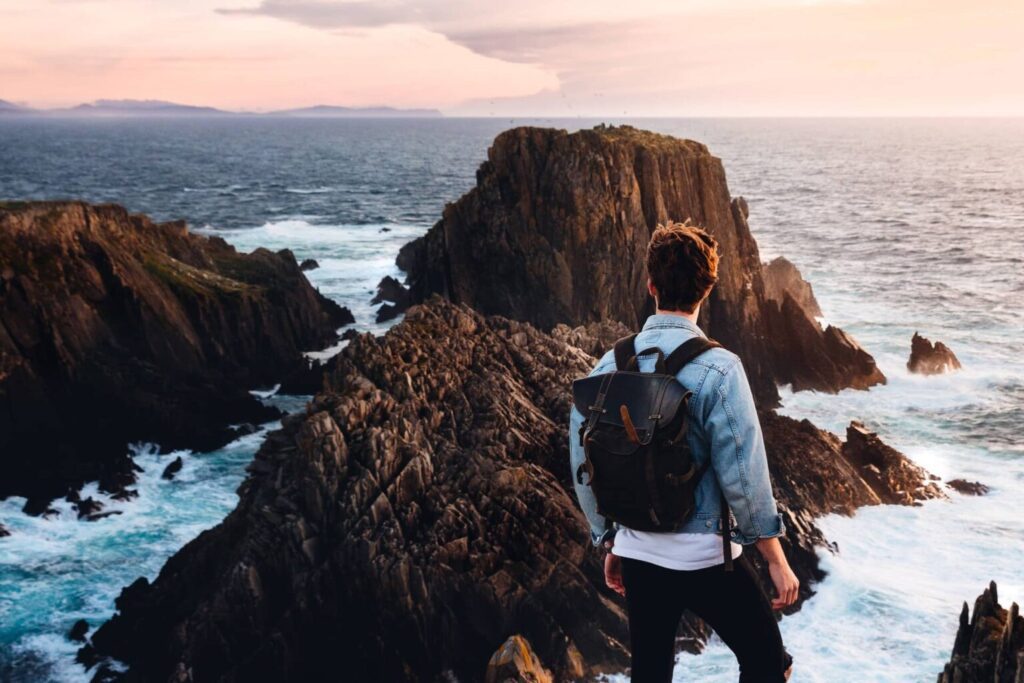
Is Slow Travel the New Luxury Travel?
A quick guide to embrace slowness in your next adventure
The philosophy promoting a “slow” lifestyle is built on the idea that by taking the time to experience cuisine, design, wine, nature, or cities one can develop a deeper appreciation of the things that make life great. Slowness has conquered the world of food over the course of the past decade and is now changing the way people travel. But what does slow travel (or slow tourism) mean exactly?
The emergence of low-cost airlines has made travel more accessible than ever before, making quick weekend escapes to different countries and short breaks popular among large groups of people all over the world. Flight prices have been decreasing consistently since the early 2000s and according to GlobalData, low-cost airlines have sold 1.7 billion tickets in 2016, 88% more than a decade earlier. Millions of people, especially in Europe, have taken advantage of this shift in the travel industry to visit holiday destinations during their free time. Frequent, short trips have become common, especially among millennials.
While the influx of tourists has benefited the economy of several destinations, this form of travel has its downsides. Package-deals and low-cost carriers may have democratized travel, but they often provide superficial experiences, that do not allow people to fully immerse themselves in the culture and history of a place. Additionally, flying is the most polluting method of transportation available, emitting more greenhouse gasses than any other vehicle. The slow travel movement aims to reverse this trend, promoting an approach to travel that is focused on empathy, understanding, and sustainability.
The idea behind the movement is that the real pleasure of travel is to discover the life of a place, to fully savor its culture and customs. In practical terms, this translates into favoring overland journeys rather than flights, choosing family-run or small-scale accommodation options rather than hotel chains, and forgetting about “must-do” lists.
In a sense, slow travel is nothing new. Beat Generation author Jack Kerouac popularized, spontaneous, overland travel with his 1957 novel “On the Road,” and hippies in the Sixties and Seventies were already exploring continents at a slow pace, moving from Europe and the US to Pakistan, India, and Nepal over the course of months, without ever taking a flight. While the unstable political situation of many countries along the way has made the “Hippie Trail” more difficult to complete today, many tools and platforms are now available to assist people willing to experience travel slowly.
The most helpful tools for overland travel
There are many reasons why people choose to travel by land rather than by air, and one of them is the spontaneity of not having to plan too much in advance, of being able to shape the itinerary according to what happens along the way.
As far as public transport is concerned, there are dozens of sites to refer to, both to compare prices and to plan routes. Although it may seem that companies like Flixbus have monopolized the European low-cost coach market, there are many routes and companies, there are many regional lines that can be used to travel cheaply to famous and lesser known destinations. Omio allows you to compare all the options available, making bus travel pretty much effortless. Trainline applies the same concept to trains, displaying all the various tickets available from the train companies that travel on the routes of your choice. Seat61, on the other hand, contains detailed information on the world of rail travel. In this website you will find articles on moving around by train in almost every country in the world, in-depth information on how to follow legendary routes – such as the Trans-Siberian Railway – and clear explanations on how to interpret the information written on tickets in places where language is an obstacle.
Dealing with bureaucracy on the road

Traveling overland also has its disadvantages, especially if you are crossing continents for months on end and can’t prepare every detail of your journey in advance. One of the common complications in some parts of the world is having to deal more often with the bureaucracy necessary to access countries. Project Visa is useful to understand if and when you need a visa, although it is important to remember that only the official websites of the embassies should be considered reliable.
The Overlanding Association, on the other hand, is a non-profit organization created to support overland travellers. On their website you can find links to Facebook groups about overland travel in all continents, but also tips, maps and tables showing the documents required to cross borders with your own vehicle. An excellent alternative is the rich Lonely Planet forum, Thorn Tree, which now contains first-hand information on pretty much every corner of the globe.
What about cycling?
One category of travelers that deserves a separate paragraph is cyclists. Those who move by bike may not have to worry about finding rides or comparing ticket costs, but that doesn’t mean going without any help. Bikeroll allows you to create routes to travel on two wheels, with maps that show elevation and distance and vary depending on the type of bike you choose to use. Those who intend to ride for long periods of time can also take advantage of the hospitality of members of the WarmShowers community, a platform similar to Couchsurfing dedicated to bicycle travelers. If focusing on hospitality doesn’t work, you can always opt for the micro-campsites of Campspace, where it is possible to rent a private space to pitch your tent in.

4 of the most epic slow travel journeys in the world
Clearly, to practice slow travel the luxury of time is essential. If you are planning a long-term, long-distance journey, here are five of the most incredible overland trips you can take around the world.
The Trans-Siberian Railway
A trip on the Trans-Siberian Railway means travelling for nearly 6000 miles from Moscow to Vladivostok or Beijing. The longest rail journey in the world will take you from remote Siberian towns to former Soviet cities and the incredible landscapes of the Russian steppe. For many the highlight of the journey is Lake Baikal, one of the deepest lakes in the world, surrounded by a network of hiking paths known as the Great Baikal Trail. Completing the Trans-Siberian can take as little as nine days if you never get off the train, however three weeks are considered the bare minimum to fully experience all that Russia has to offer.
The Mongol Rally
Organized yearly by The Adventurists, the Mongol Rally is an adventure like no other. To participate in the charity race starting in London and ending in Ulaanbataar, one has to follow few, simple rules: drive in a car that has an engine of 1.2 liters or lest, donate GBP 500 to charity, and make sure to take the car back to its home country. The race is unsupported, it has no set route and usually takes from a month to six weeks to complete, running through countries such as Azerbaijan, Uzbekistan, Kazakhstan, Kyrgyzstan.
Jack Kerouac’s On The Road
On September 5, 1957, Jack Kerouac’s On The Road was published by Viking Press. The book, a symbol of the Beat Generation, recounts the travels of the author’s alter ego, Sal Paradise, through the United States and Mexico. Written on a roll of paper over 36 meters long (instead of normal typewriter sheets, to avoid interrupting the creative flow), On The Road narrates the protagonist’s escapes from New York to the West Coast, describing his encounters with women, poets, jazz musicians. The first journey undertaken by Sal Paradise takes him from New York to San Francisco. Later, he will reach LA, Denver, Mill City, Chicago, Detroit, before heading south to Mexico City. Today, it is possible to retrace Paradise’s step exactly, thanks to a free guide titled On the Road for 17,527 Miles, created by Gregor Weichtbrodt, which includes GPS coordinates.
Around Australia
Driving (or cycling) around Australia is a trip that will take you from the lush forests of the south, to the tropical north and the dry deserts of the outback, with the opportunity to see untamed wildlife that exists nowhere else. The east coast of Australia is undoubtedly the busiest part of the country, with the country’s three major cities are located and the area where over 80% of the population lives. Contrary to the west coast, which is enclosed in a single state, the east coast is divided between Victoria, New South Wales and sunny Queensland, extending over 2000 miles from Melbourne to Cairns. The “Wild West”, on the other hand, is the route less traveled, the one that starts in Darwin and ends in Perth, the most isolated capital city in the world, through rocky, red desert landscapes, vast national parks, and oceans filled with marine life. Camps Australia Wide, is the country’s travelers bible, collecting hundreds of sites where it is legal to camp for free.
4 of the most epic slow travel journeys in the world
Clearly, to practice slow travel the luxury of time is essential. If you are planning a long-term, long-distance journey, here are five of the most incredible overland trips you can take around the world.
The Trans-Siberian Railway
A trip on the Trans-Siberian Railway means travelling for nearly 6000 miles from Moscow to Vladivostok or Beijing. The longest rail journey in the world will take you from remote Siberian towns to former Soviet cities and the incredible landscapes of the Russian steppe. For many the highlight of the journey is Lake Baikal, one of the deepest lakes in the world, surrounded by a network of hiking paths known as the Great Baikal Trail. Completing the Trans-Siberian can take as little as nine days if you never get off the train, however three weeks are considered the bare minimum to fully experience all that Russia has to offer.
The Mongol Rally
Organized yearly by The Adventurists, the Mongol Rally is an adventure like no other. To participate in the charity race starting in London and ending in Ulaanbataar, one has to follow few, simple rules: drive in a car that has an engine of 1.2 liters or lest, donate GBP 500 to charity, and make sure to take the car back to its home country. The race is unsupported, it has no set route and usually takes from a month to six weeks to complete, running through countries such as Azerbaijan, Uzbekistan, Kazakhstan, Kyrgyzstan.
Jack Kerouac’s On The Road
On September 5, 1957, Jack Kerouac’s On The Road was published by Viking Press. The book, a symbol of the Beat Generation, recounts the travels of the author’s alter ego, Sal Paradise, through the United States and Mexico. Written on a roll of paper over 36 meters long (instead of normal typewriter sheets, to avoid interrupting the creative flow), On The Road narrates the protagonist’s escapes from New York to the West Coast, describing his encounters with women, poets, jazz musicians. The first journey undertaken by Sal Paradise takes him from New York to San Francisco. Later, he will reach LA, Denver, Mill City, Chicago, Detroit, before heading south to Mexico City. Today, it is possible to retrace Paradise’s step exactly, thanks to a free guide titled On the Road for 17,527 Miles, created by Gregor Weichtbrodt, which includes GPS coordinates.
Around Australia
Driving (or cycling) around Australia is a trip that will take you from the lush forests of the south, to the tropical north and the dry deserts of the outback, with the opportunity to see untamed wildlife that exists nowhere else. The east coast of Australia is undoubtedly the busiest part of the country, with the country’s three major cities are located and the area where over 80% of the population lives. Contrary to the west coast, which is enclosed in a single state, the east coast is divided between Victoria, New South Wales and sunny Queensland, extending over 2000 miles from Melbourne to Cairns. The “Wild West”, on the other hand, is the route less traveled, the one that starts in Darwin and ends in Perth, the most isolated capital city in the world, through rocky, red desert landscapes, vast national parks, and oceans filled with marine life. Camps Australia Wide, is the country’s travelers bible, collecting hundreds of sites where it is legal to camp for free.
